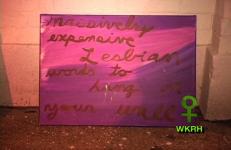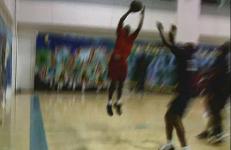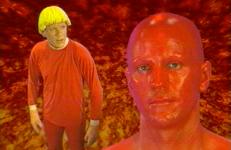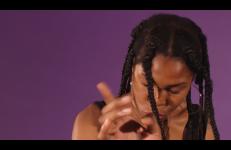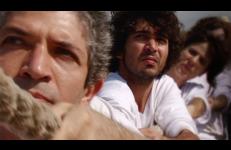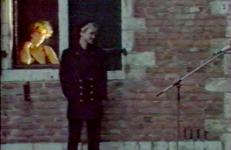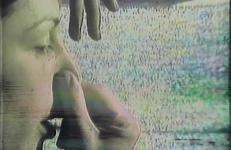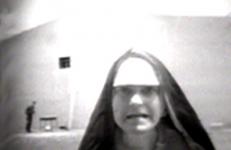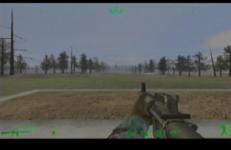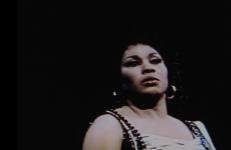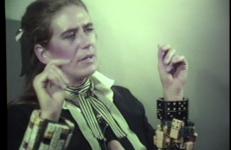The second installment of the collaborative project New Report, an ongoing series of performances and videos, Artist Unknown features K8 Hardy (founder of the queer feminist art collective LTTR) and Wynne Greenwood (of Tracy and the Plastics) playing Henry Irigaray and Henry Stein-Acker-Hill, and anchor and roving correspondent for WKRH, a feminist TV news station whose tagline is "pregnant with information." Based on documentation of a live, digital communication in real time between Greenwood at Foxy Production Gallery and Hardy on the street in New York.
Performance
In this episode of Glennda and Friends, Glennda Orgasm and Mark Allen drink at Marie's Crisis Café, a piano bar in Manhattan. They interview other bar patrons and discuss topics including politics, Judy Garland, and the idea of mid-life crisis.
An episode of Glennda and Friends, hosted by Glennda Orgasm and Mark Allen.
Collaboration with Joseph Scheer (print making artist specializing in moths) and Rebekkah Palov.
Choreography and editing by Eiko Otake, assisted by Rebekkah Palov.
Eiko is deeply grateful to Institute for Electronic Arts, Alfred University.
From the performance by the same name, by Suzanne Lacy, Stan Hebert, Councilwoman Sheila Jordan, Frank Williams, Officer Terrance West, Mike Shaw, and Annice Jacoby, Oakland, 1995-6. Suzanne Lacy worked alongside youth activists, city council members and the mayor’s office to draft a Youth Policy Initiative that would create a dedicated stream of funding to serve youth needs. In the spring of that year, No Blood/No Foul was a performance on the eve of the Policy’s vote by the Oakland City Council, with Mayor, Council members and a large audience in attendance.
This is a story of friendship between two independent female artists and their body memories each willingly carry. In January 2020, New York based, interdisciplinary performing artist Eiko Otake arrived in Beijing to visit Wen Hui, a Chinese choreographer and filmmaker. Eight years apart, Eiko grew up in postwar Japan and Wen during the Cultural Revolution. They planned to visit each other for a month to converse and collaborate. The surge of COVID-19 abruptly cut off Eiko's visit and the pandemic has made Wen's visit to the USA impossible but the collaboration continued.
A trans performers enacts an improvised strip-tease in silence, adhering to directions of positioning and movement. The performance fails to reveal genitals. Perspective oscillates between three stages of distance from the subject; re-focusing and reframing the (lack of) genital revelation.
A short story about new bodies, the power of denial, and a state of no sunshine. Two infantile bodies float in a cyberspace ball, connected by two subconscious bodies in the background. The attempt at unification and metamorphosis is interrupted by one part as the other is liberated. A glance over the shoulder means destruction.
The sources for the soundtrack are fragments of the childish voices of early Michael Jackson and Stevie Wonder songs.
Performed by Bjørn and Roald Melhus.
The earliest of Benglis's videoworks, Noise calls attention to the assemblage element of video by allowing the image to disintegrate into static between edits. Benglis also plays back several generations of image and soundtrack to introduce increasing amounts of distortion. Conversation is reduced to unintelligible noise, resulting in the disassociation of sound and image that to some extent characterizes her later work.
This title was in the original Castelli-Sonnabend video art collection.
...were repeatedly raised and lowered and people grew exhausted from never knowing if the moment was at hand or was still to come A project of The Speculative Archive "Peace. I don't want it. Justice. Why? Victory? Makes me sick! Love? What a pity. Freedom? Ugly! Friendship? My ass!" Rami Farah, a young Syrian performer, uses various modes of address such as a promise, a threat, a curse, a joke, a lament, and a premonition in order to speak to the current state of affairs in Syria and the Middle East.
...were repeatedly raised and lowered and people grew exhausted from never knowing if the moment was at hand or was still to come A project of The Speculative Archive "Peace. I don't want it. Justice. Why? Victory? Makes me sick! Love? What a pity. Freedom? Ugly! Friendship? My ass!" Rami Farah, a young Syrian performer, uses various modes of address such as a promise, a threat, a curse, a joke, a lament, and a premonition in order to speak to the current state of affairs in Syria and the Middle East.
Inspired by a riff on a popular joke “Everybody wanna be a black woman but nobody wanna be a black woman,” Notes On Gesture is a video comparing authentic and dramatic gestures. The piece uses the 17th Century text Chirologia: Or the Natural Language of the Hand as a guide to create an inventory of gestures for performance. The piece alternates between title cards proposing hypothetical situations and short, looping clips that respond. The actor uses her body to quote famous, infamous, and unknown women.
Hirsch’s most ambitious film to date and the pinnacle of his trilogy, Nothing New depicts the epic rescue mission of a man whose parachute is caught on electricity power lines. Involving hundreds of participants in a desolate field facing the Jordanian border in the Jordan Valley of Israel, this communal cinematic endeavor aims to re-unite, if only for a brief moment, the collective spirit of the socialist Kibbutz movement in Israel, a movement that has undergone significant ideological modifications.
Footage from a performance produced at Forum en Scene in Middleburg, Holland of the players continually enacting the same tasks. Nothing To Lose opens with a young, androgynous sailor standing between two buildings, while the song Nothing To Lose plays on a record player. The camera pans to two people in the national costume of Zeeland: one is peeling cucumbers and the other is washing sheets, shouting, “Good manners ruin good food.” A woman sits in her window, fingering a string of pearls and shouting to the sailor.
Throughout the video, Benglis asks "Now?" and "Do you wish to direct me?" and repeats commands like "Start the camera" and "I said start recording." As in On Screen, she makes faces and sounds in reply to the images on a monitor; at one point she appears to kiss herself. The word "now", used as both question and command, focuses attention on the deceptive "real" time of video, and reveals the structure underlying her presence in the video.
A classic example of feminist performance videos of the 1970s, which often incorporated autobiography, expansion of self through personae, and assertions of a new identity for women. In Nun and Deviant the performers come to happier terms with their identities both as women and as artists.
A classic example of feminist performance videos of the 1970s, which often incorporated autobiography, expansion of self through personae, and assertions of a new identity for women. In Nun and Deviant the performers come to happier terms with their identities both as women and as artists.
O.U.T. is a work documenting the emergence of computer games which train players to fight in cities among civilians, (Military Operations in Urban Terrain). O.U.T. contains sampled footage and machinima (stories told with video games) from five military simulation games. Following is a documentation of the performance, (Operation Urban Terrain), an urban wireless intervention by Anne-Marie Schleiner and an international cast of game expert and art activist collaborators.
‘ODDS AND ENDS’ is a dazzling patchwork of moods, lost and found, for the eye to savor.
Offering was co-commissioned by Dancing in the Streets (New York), the Walker Art Center (Minneapolis, where the proscenium version premiered January 9, 2003) and the University of Arizona (Tucson).
Offering is a ritual of regeneration after loss. People everywhere have lost ideals and landscapes that were dear to them. Offering was originally developed as a mobile outdoor work. This transportable dance or living site "installation" can be brought into communities to serve a communal need for a ritual of mourning.
In 1985 the great soprano Leontyne Price sang the title role in Verdi’s Aida as her farewell opera. After the ‘O patria mia’ aria, the audience breaks into a four-minute applause. Oh My Homeland is the third in a series of minimal single shot 16mm films. It’s a film about representation, art, and material exchange. It’s a film about endings. It’s a film about identity, love, power, patriotism and the transcendent potential of art through the viewing of a face receiving adoration.
A historical interview originally recorded in 1983.
Interview by Joan Livingstone.
Three nuns in dark sunglasses sit at a table playing cards while a nurse is inteviewed about "what death looks like” on the soundtrack. As the nurse speaks, in medical detail, of death as a natural process, the nuns sit with party hats on their heads and light birthday candles stuck in bananas. On Death and Dying is a mocking and macabre look at the institutions of death—how hospitals and religions “manage” death. The tape resolves in the conclusion that “death is a job that you do by yourself.”
"Benglis manipulates generations of video footage to confound our sense of time; she implies an infinite regression of time and space — Benglis making faces in front of a monitor of her making faces in front of a monitor of her... ad infinitum. The viewer retains a sense of the images sequentiality, although the sequence of creation is not revealed in a logical, orderly fashion, and is heavily obscured by the random layering and continual repetition of aural and visual components."
In this episode of The Brenda and Glennda Show, Glennda meets up with guest co-host Joan Jett Blakk to discuss Blakk’s 1992 presidential run. The pair interview people on the street outside of the 1992 Democratic Convention. They discuss topics including the police state, weaknesses of the two-party political system, feminism, and political elitism.
Documentary of the New York experimental theater company The Wooster Group on tour in Glasgow, Scotland, 2000, installing their production of HOUSE/LIGHTS.




